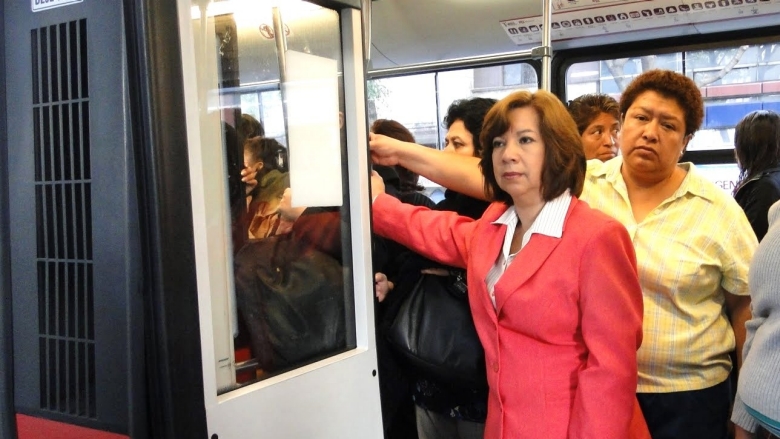
10 Mar, 2016
World Bank Helps Promote Safe Travel for Women in Public Transport Systems
Washington DC, 08 March 2016, (World Bank News Feature) When you take public transportation, whether a metro or a bus, you may not automatically think about gender differences. But men and women’s experiences with transport systems differ greatly, particularly when related to their physical security and safety.
Recent research has shown high levels of violence against women and girls (VAWG) in public transport and adjacent public spaces in many cities around the world. Common types of abuse on public transport range from leering looks and offensive gestures to unwanted touching and sexual assault.
 Photo: Paullen Osse |
As the global community marks Women’s International Day on March 8th, the World Bank is putting more emphasis on preventing the potential violence and harassment that women and girls may face while using public transport systems in both developed and developing countries.
The issue of women’s security in public transportation becomes even more critical since it is women, rather than men, who most depend on public transport to meet their mobility needs. Therefore, women’s safety is becoming a priority for the World Bank’s transport portfolio which constitutes nearly one-fifth of the Bank’s total lending. These investments are critical for increasing access to jobs, healthcare and education.
“When you look at who takes public transport, women depend much more on public transport than men, relatively speaking… so ensuring their safety and security, their ability to get to their jobs, and to get their kids to school in a safe manner, is absolutely essential and we need to focus on that,” says Pierre Guislain, Senior Director, World Bank Transport and ICT Global Practice.
 Pierre Guislain, Senior Director, World Bank Transport and ICT Global Practice. |
To increase women’s security in public transport, the World Bank is collaborating across sectors to identify innovative, practical, and proven solutions that will enable women and girls to safely access services, markets and jobs.
Holistic interventions
Today, an increasing number of World Bank projects include practices to prevent violence against women in public transport systems. These holistic interventions are combining several multi-sectoral strategies to achieve greater impact. Some of these include:
- community involvement in project design, implementation, and monitoring;
- innovative use of ICT to report cases of harassment, generate relevant data, and improve access to information or services that help address harassment;
- training of transport staff on physical security and gender-related topics, and;
- use of communication campaigns to raise awareness and try to change social norms, attitudes and overall behavior related to violence against women and girls.
The Traveling Safely (Viajemos Seguras) program In Mexico City, for example, aims to prevent, address, and penalize violence against women and girls (VAWG) in public transport. The program was developed and is being implemented by several federal and municipal government agencies, including InMujeres DF and the city’s Mass Transit System Agency.
The initiative includes four main components: service kiosks inside Metro stations where users can seek help or report incidents; training for transport employees, including drivers and operators, on VAWG; delivery of VAWG prevention campaigns in the public transport vehicles and stations; and women-only cars in Metro and bus systems. Fifty-eight percent of the Metro lines and 100% of the Bus Rapid Transit (BRT) lines, for instance, have now implemented the women-only car policy.
Gender-blind no more
Development of transport infrastructure and services has historically been largely gender-blind since it has not taken gender roles and men’s and women’s different uses of transport into account.
Women and men’s differing roles, however, determine their travel decisions and transportation needs. Mobility patterns are different for women and men. Women’s travel patterns are more complex and heterogeneous than men’s, particularly in low and middle-income countries. Because they tend to take care of children and/or older parents, women need to make shorter trips in both time and distance, be more willing to combine trips, and travel with minors and with more packages than men do.
“High levels of harassment and other abuse in public transportation can limit women’s willingness to travel, reducing their earning options. Women are at greater risk of violence from strangers on public transportation and walking to and from transportation,” notes a recent Resource Guide on Violence against Women & Girls.
Thus, ensuring access to safe, quality, affordable and reliable transportation is essential to free women’s time for productive activities and enable better access to health, education, markets and jobs.
Guislain noted that as part of any transport project’s environmental and social impact assessment, it is crucial for these assessments to properly document the risks that women and girls are exposed to.
“These risks differ from city to city or country to country, so it is really important to get a better feel for what these major risks and issues are,” he said. “And then making sure we design interventions to reflect those risks, and pursue them rather pro-actively.”
Acting pro-actively also requires the involvement of local communities during the design, implementation and monitoring of a transport project.
“If you really want to have impact in the way women and girls are being treated in public transportation, there is clearly a community dimension, a social norm dimension which we cannot ignore. And so it is crucial to work with stakeholders upfront in the design of these interventions, and in the implementation and follow up,” explained Guislain. “So it’s a bit of a combination of factors that we need to bring to bear: technology can play an important role, as well as infrastructure and service system design, but it is also key to engage women and girls, engage with the community at large, and design systems that will also lead to a change in behavior because that’s part of the issue.”



Liked this article? Share it!